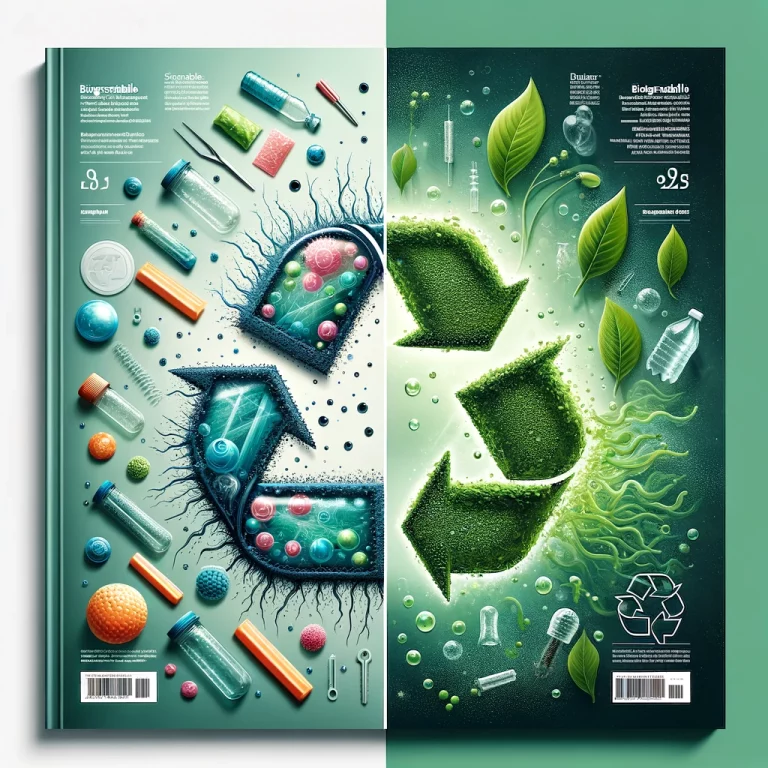Exploring Biomacromolecules: Structure, Function, and Technological Applications
This review investigates biomacromolecules, focusing on their structural-functional linkages as well as emerging technological applications in medicine and biotechnology, with the goal of anticipating substantial advances in research and practical applications.

Introduction to Biomacromolecules
Biomacromolecules are fundamental components of biological systems, contributing significantly to a variety of biological activities. They are big molecules that are necessary for life and provide functions like as energy storage, structural support, and information transfer within cells (Zhang et al. 2014). Proteins, nucleic acids, carbohydrates, and lipids are the four major categories of biomacromolecules, each with its own role and relevance in biological systems (Zhang et al. 2014). Proteins play a variety of roles in biological processes, including enzymatic activities, cell structure, and signaling (Zhang et al., 2014). Nucleic acids, such as DNA and RNA, are responsible for genetic information storage and expression (Zhang et al., 2014). Carbohydrates provide energy while also playing a role in cellular recognition and signaling. Lipids are essential for cell membrane shape, energy storage, and signaling (Ling and Hadinoto, 2022).
Because of their exceptional biophysical and biochemical properties, biomacromolecules have sparked great interest in a variety of domains, including drug delivery, tissue engineering, and biomedical applications (Zhang et al., 2018). They have been used as carriers in drug delivery systems and tissue engineering because of their biocompatibility, durability, and ability to target specific areas (Zhang et al., 2018). Biomacromolecules have also been investigated for their potential in pulmonary administration of medicinal drugs, demonstrating their versatility in biomedicine (Hussain et al., 2021).
Furthermore, the significance of nucleic acids has been highlighted in terms of oxidative stress and nucleic acid oxidation in disorders such as chronic renal disease (Sung et al., 2013). Nucleic acid changes, particularly oxidative products, have been intensively researched, providing insight into their role in disease etiology (Sung et al., 2013). Furthermore, nucleic acids’ roles have evolved beyond their traditional function as genetic material, with applications in molecular structure creation and molecular wires in biotechnology (Olejniczak et al., 2018).
In materials science and nanotechnology, biomacromolecules have been integrated into various nanoarchitectures, such as metal-organic frameworks, to improve catalytic activity and bioactivity for biosensing and biomedical applications (Su et al., 2022). Furthermore, biomacromolecules have been used as immobilization platforms in biomedical applications, indicating their versatility (Wang et al., 2022).
Proteins, nucleic acids, carbohydrates, and lipids are all examples of biomacromolecules, each with their own set of functions and significance. Their varied features have led to substantial research in a variety of domains, including drug delivery, tissue engineering, and nanotechnology, underlining their significance and potential for medicinal and biotechnological applications.
Structure and Function Relationships
Biomacromolecules’ biological functions are heavily influenced by their structural properties. Proteins, for example, have a distinctive three-dimensional structure that is inextricably related to their function. Enzyme specificity exemplifies this relationship, since the precise arrangement of amino acids in the active site allows for selective binding and catalysis of certain substrates. Hegyi and Gerstein (1999) underline the importance of directing protein assembly to create highly organized nanostructures, underlining the direct relationship between protein structure and function. Furthermore, Luo et al. (2016) show that proteins, enzymes, and DNA stimulate the creation of protective metal-organic framework coatings, highlighting the impact of biomacromolecular structure on the surrounding environment and interactions.
Nucleic acids, particularly RNA, demonstrate the link between structure and function by their variety. RNA molecules can adopt a variety of structural conformations, including hairpin loops and pseudoknots, allowing them to perform a wide range of functions such as catalysis, gene control, and chemical recognition. Carothers et al. (2004) investigate the informational complexity and functional activity of RNA structures, highlighting the deep link between RNA structure and dynamic functional states. Furthermore, the study of Roque-Borda et al. (2022) acknowledges RNA’s functional plasticity and its significance in data fitting, emphasizing the adaptability of RNA structures for therapeutic objectives.
The structure-function interactions of biomacromolecules, particularly enzymes and RNA, are critical for understanding their biological relevance and applications. These examples demonstrate the importance of biomacromolecular structure in determining their diverse and crucial activities in biological systems.
Technological Applications and Future Prospects
Recent advances in biomacromolecule-based technologies in medicine and biotechnology have opened the door to novel applications and future breakthroughs. Proteins, nucleic acids, and carbohydrates have all been widely studied for their potential roles in drug delivery, tissue engineering, and therapeutic technologies. For example, biomacromolecules have been used as carriers in drug delivery systems and tissue engineering, with advantages over synthetic material-based carriers in terms of stability, safety, and ease of fabrication (Zhang et al. 2018). Furthermore, the development of protein-polymer conjugates has paved the way for the creation of new biomacromolecular products, which could lead to advances in genetic and tissue engineering (Baker et al., 2019).
Advances in biomacromolecule-based therapeutic technologies, such as genes, oligonucleotides, and proteins, have highlighted the need for technologies that improve the efficiency of delivering therapeutic molecules into cells, particularly the cytosol and nucleus (Nakase et al., 2010). Furthermore, recent advances in the manufacturing and deployment of precise assemblies based on proteins and carbohydrates have created new difficulties, goals, and opportunities for future biomacromolecular research (Li & Chen, 2022).
Future research directions in biomacromolecular studies promise substantial discoveries in a variety of technology applications. De novo design of functional biomacromolecules is of tremendous interest for fundamental science and technological applications, such as the creation of new catalysts, pharmaceuticals, and high-performance materials (Liu et al., 2023). Furthermore, structurally well-defined DNA nanotubes are projected to have a wide range of technical applications, including medication delivery and 3D structure determination (Qian et al., 2013). The study of biomaterials, which includes major advancements in chemistry applied to medicine, is a fast increasing science with enormous future potential (Velez, 2024).
Recent advances in biomacromolecule-mediated pulmonary delivery of therapeutic agents have shown promise in overcoming challenges such as clearance and internal medicine, highlighting the potential for future breakthroughs in this field (Hussain et al., 2021). Furthermore, nanoplasmonic sensing designs for decoding membrane curvature-dependent biomacromolecular interactions have emerged as a viable approach for nanotechnology and cell membrane structures (Ferhan et al., 2018). The use of spatially controlled hierarchical nanoarchitectures in ultrasensitive immunoassays has shown tremendous promise for quantitative target analysis in biomedical applications (Su et al., 2022).
To summarize, recent advances in biomacromolecule-based technologies have cleared the road for novel applications in medicine and biotechnology. Future research directions in biomacromolecular studies have the potential to lead to substantial discoveries in a wide range of technological applications, including medication delivery, tissue engineering, nanotechnology, and biomedical sensing.
References
Hussain, Y., Cui, J., Khan, H., Makvandi, P., & Alam, W. (2021). Biomacromolecule-mediated pulmonary delivery of sirna and anti-sense oligos: challenges and possible solutions. Expert Reviews in Molecular Medicine, 23. https://doi.org/10.1017/erm.2021.25
Ling, J. and Hadinoto, K. (2022). Deep eutectic solvent as green solvent in extraction of biological macromolecules: a review. International Journal of Molecular Sciences, 23(6), 3381. https://doi.org/10.3390/ijms23063381
Olejniczak, A., Nawrot, B., & Lesnikowski, Z. (2018). Dna modified with boron–metal cluster complexes [m(c2b9h11)2]—synthesis, properties, and applications. International Journal of Molecular Sciences, 19(11), 3501. https://doi.org/10.3390/ijms19113501
Su, D., Wang, T., Li, A., Ma, Y., Liu, X., Wang, C., … & Lu, G. (2022). Metal–organic frameworks nanoarchitectures boost catalytic activity for the construction of sensitive immunosensor. Advanced Functional Materials, 32(36). https://doi.org/10.1002/adfm.202204130
Sung, C., Hsu, Y., Chen, C., Lin, Y., & Wu, C. (2013). Oxidative stress and nucleic acid oxidation in patients with chronic kidney disease. Oxidative Medicine and Cellular Longevity, 2013, 1-15. https://doi.org/10.1155/2013/301982
Wang, X., Lewis, D., Wang, G., Meng, T., Zhou, S., Zhu, Y., … & Gao, S. (2022). Covalent organic frameworks as a biomacromolecule immobilization platform for biomedical and related applications. Advanced Therapeutics, 5(10). https://doi.org/10.1002/adtp.202200053
Zhang, W., Ma, Z., Du, L., & Li, M. (2014). Design strategy for photoinduced electron transfer-based small-molecule fluorescent probes of biomacromolecules. The Analyst, 139(11), 2641-2649. https://doi.org/10.1039/c3an02379f
Zhang, Y., Sun, T., & Jiang, C. (2018). Biomacromolecules as carriers in drug delivery and tissue engineering. Acta Pharmaceutica Sinica B, 8(1), 34-50. https://doi.org/10.1016/j.apsb.2017.11.005
Carothers, J., Oestreich, S., Davis, J., & Szostak, J. (2004). Informational complexity and functional activity of rna structures. Journal of the American Chemical Society, 126(16), 5130-5137. https://doi.org/10.1021/ja031504a
Hegyi, H. and Gerstein, M. (1999). The relationship between protein structure and function: a comprehensive survey with application to the yeast genome. Journal of Molecular Biology, 288(1), 147-164. https://doi.org/10.1006/jmbi.1999.2661
Luo, Q., Hou, C., Bai, Y., Wang, R., & Liu, J. (2016). Protein assembly: versatile approaches to construct highly ordered nanostructures. Chemical Reviews, 116(22), 13571-13632. https://doi.org/10.1021/acs.chemrev.6b00228
Roque-Borda, C., Gualque, M., Fonseca, F., Pavan, F., & Santos-Filho, N. (2022). Nanobiotechnology with therapeutically relevant macromolecules from animal venoms: venoms, toxins, and antimicrobial peptides. Pharmaceutics, 14(5), 891. https://doi.org/10.3390/pharmaceutics14050891
Baker, S., Kaupbayeva, B., Lathwal, S., Das, S., Russell, A., & Matyjaszewski, K. (2019). Atom transfer radical polymerization for biorelated hybrid materials. Biomacromolecules, 20(12), 4272-4298. https://doi.org/10.1021/acs.biomac.9b01271
Ferhan, A., Jackman, J., Malekian, B., Xiong, K., Emilsson, G., Park, S., … & Cho, N. (2018). Nanoplasmonic sensing architectures for decoding membrane curvature-dependent biomacromolecular interactions. Analytical Chemistry, 90(12), 7458-7466. https://doi.org/10.1021/acs.analchem.8b00974
Hussain, Y., Cui, J., Khan, H., Makvandi, P., & Alam, W. (2021). Biomacromolecule-mediated pulmonary delivery of sirna and anti-sense oligos: challenges and possible solutions. Expert Reviews in Molecular Medicine, 23. https://doi.org/10.1017/erm.2021.25
Li, L. and Chen, G. (2022). Precise assembly of proteins and carbohydrates for next-generation biomaterials. Journal of the American Chemical Society, 144(36), 16232-16251. https://doi.org/10.1021/jacs.2c04418
Liu, J., Jiang, T., Zhao, J., Liu, M., Chen, F., Lin, L., … & Mao, C. (2023). Rational design of abasic site-containing dna triplexes to bind small molecules with low nanomolar dissociation constants. Analytical Chemistry, 95(26), 9754-9760. https://doi.org/10.1021/acs.analchem.2c05777
Nakase, I., Kobayashi, S., & Futaki, S. (2010). Endosome‐disruptive peptides for improving cytosolic delivery of bioactive macromolecules. Biopolymers, 94(6), 763-770. https://doi.org/10.1002/bip.21487
Qian, H., Tian, C., Yu, J., Guo, F., Zheng, M., Jiang, W., … & Mao, C. (2013). Self‐assembly of dna nanotubes with defined diameters and lengths. Small, 10(5), 855-858. https://doi.org/10.1002/smll.201301891
Su, D., Li, H., Zhou, R., Zhao, L., Li, A., Liu, X., … & Lu, G. (2022). Embedding proteins within spatially controlled hierarchical nanoarchitectures for ultrasensitive immunoassay. Analytical Chemistry, 94(16), 6271-6280. https://doi.org/10.1021/acs.analchem.2c00269
Velez, C. (2024). Synthesis and characterization of gelatin methacryloyl: introducing chemistry students to the applications of hydrogels in medicine. Journal of Chemical Education, 101(3), 1171-1179. https://doi.org/10.1021/acs.jchemed.3c00894
Zhang, Y., Sun, T., & Jiang, C. (2018). Biomacromolecules as carriers in drug delivery and tissue engineering. Acta Pharmaceutica Sinica B, 8(1), 34-50. https://doi.org/10.1016/j.apsb.2017.11.005



